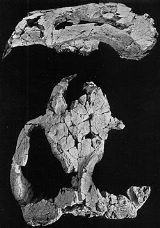
Taeniolabis
Encyclopedia

Genus
In biology, a genus is a low-level taxonomic rank used in the biological classification of living and fossil organisms, which is an example of definition by genus and differentia...
of extinct mammal
Mammal
Mammals are members of a class of air-breathing vertebrate animals characterised by the possession of endothermy, hair, three middle ear bones, and mammary glands functional in mothers with young...
from the Paleocene
Paleocene
The Paleocene or Palaeocene, the "early recent", is a geologic epoch that lasted from about . It is the first epoch of the Palaeogene Period in the modern Cenozoic Era...
of North America
North America
North America is a continent wholly within the Northern Hemisphere and almost wholly within the Western Hemisphere. It is also considered a northern subcontinent of the Americas...
. It is the largest known member of the extinct order Multituberculata
Multituberculata
The Multituberculata were a group of rodent-like mammals that existed for approximately one hundred and twenty million years—the longest fossil history of any mammal lineage—but were eventually outcompeted by rodents, becoming extinct during the early Oligocene. At least 200 species are...
, reaching weights of perhaps 30 kg. It is within the suborder of Cimolodonta
Cimolodonta
The Cimolodonta are a taxon of extinct mammals that lived from the Cretaceous to the Eocene. They were some of the more derived members of the extinct order Multituberculata. They probably lived something of a rodent-like existence until their ecological niche was assumed by true rodents...
and is a member of the superfamily Taeniolabidoidea
Taeniolabidoidea
Taeniolabidoidea is a group of extinct mammals known from North America and Asia. They were the largest members of the also extinct order Multituberculata. Lambdopsalis even provides direct fossil evidence of mammalian fur in a fairly good state of preservation for a 60-million-year-old animal...
. The genus was named by Edward Drinker Cope
Edward Drinker Cope
Edward Drinker Cope was an American paleontologist and comparative anatomist, as well as a noted herpetologist and ichthyologist. Born to a wealthy Quaker family, Cope distinguished himself as a child prodigy interested in science; he published his first scientific paper at the age of nineteen...
in 1882. Species have also been placed with the genera Catopsalis
Catopsalis
Catopsalis is a genus of extinct mammal from the Paleocene of North America, though some Canadian finds may be upper Cretaceous. This animal was a relatively large member of the extinct order of Multituberculata. Most Multituberculates were much smaller....
and Polymastodon Cope, 1882.
The species Taeniolabis lamberti was named by N.B. Simmons in 1987. It has been found in the Puercan (Paleocene)-age
Puercan
The Puercan North American Stage on the geologic timescale is the North American faunal stage according to the North American Land Mammal Ages chronology , typically set from 65,000,000 to 63,300,000 years BP lasting . It is usually considered to be within the Paleocene...
Tullock Formation of Montana
Montana
Montana is a state in the Western United States. The western third of Montana contains numerous mountain ranges. Smaller, "island ranges" are found in the central third of the state, for a total of 77 named ranges of the Rocky Mountains. This geographical fact is reflected in the state's name,...
. It is not quite as large as T. taoensis, but still a hefty size for a multituberculate.
The species Taeniolabis taoensis was named by Cope E.D. in 1882. It is also known as Catopsalis pollux (Cope, 1882); Polymastodon attenuatus (Cope, 1885); P. latimolis Cope, 1885; P. selenodus Osborn H.F. and Earle C., 1895; P. taoensis (Cope, 1882); T. attetuatus; T. scalper (Cope 1884); T. sulcatus (Cope 1882a); T. triserialis (Granger & Simpson, 1929). They are found in the Puercan
Puercan
The Puercan North American Stage on the geologic timescale is the North American faunal stage according to the North American Land Mammal Ages chronology , typically set from 65,000,000 to 63,300,000 years BP lasting . It is usually considered to be within the Paleocene...
-age Nacimiento Formation
Nacimiento Formation
The Nacimiento Formation is a sedimentary rock formation found in the San Juan Basin of western New Mexico and named for the Nacimiento Mountains...
of New Mexico
New Mexico
New Mexico is a state located in the southwest and western regions of the United States. New Mexico is also usually considered one of the Mountain States. With a population density of 16 per square mile, New Mexico is the sixth-most sparsely inhabited U.S...
and Wyoming
Wyoming
Wyoming is a state in the mountain region of the Western United States. The western two thirds of the state is covered mostly with the mountain ranges and rangelands in the foothills of the Eastern Rocky Mountains, while the eastern third of the state is high elevation prairie known as the High...
and in the Ravenscrag Formation of Saskatchewan
Saskatchewan
Saskatchewan is a prairie province in Canada, which has an area of . Saskatchewan is bordered on the west by Alberta, on the north by the Northwest Territories, on the east by Manitoba, and on the south by the U.S. states of Montana and North Dakota....
. This species had a 6 in. (16 cm) long skull. It was a real heavyweight; the largest known multituberculate, this creature was as big as a beaver.

